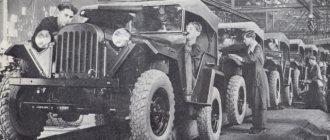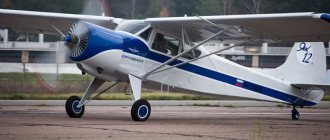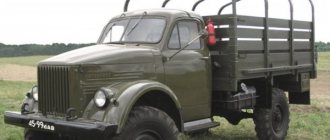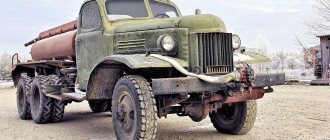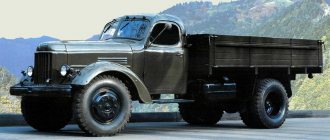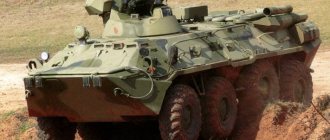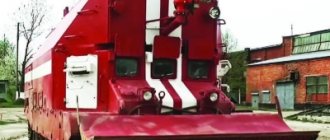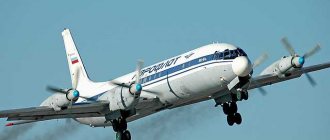In the history of the automotive industry of the Soviet Union there are many legendary models. These include both cars and trucks. Among the latter, it is worth highlighting the GAZ-66. It is believed that the ancestor of the “shishiga” was precisely the model 62. But the GAZ-62 was never an auto legend of the USSR. This is just a prototype. What is noteworthy is that under this index, the Gorky plant developed as many as three prototypes with different cabin layouts. In today's article we will look at each of them. So, what is GAZ-62? See photo, history and description of the model below.
First copy
He was born back in 1940 of the last century. In preparation for the coming war, GAZ carried out large-scale experiments with army three-axle vehicles. Thus, the first prototype received a hood layout and a 4 x 4 wheel arrangement. What is noteworthy is that the most powerful engine was used on this model. GAZ-62 was equipped with a six-cylinder gasoline unit from the GAZ-MM car. With a volume of 3.5 liters, this engine developed a power of 76 horsepower. Interesting fact: this engine has many similarities with the internal combustion engine of the American Dodge D5.
The GAZ was standardly equipped with a transfer case. It was controlled from the interior using a lever. The latter had four provisions:
To increase cross-country ability, this car was equipped with special wheels with “Ground Flu” tires measuring 34 x 7 inches.
Owner reviews
GAZ-62 has a number of interesting technical solutions for its time. Many successful tests and comparisons with analogues have shown the reliability, efficiency and high maneuverability of such machines. However, their mass production was short-lived.
Despite the advantages of such trucks, owners and experts note certain disadvantages of some assemblies. They are associated with operational maintenance and use of machines in various conditions. Most of the shortcomings were gradually eliminated during modernizations. However, in the end it was they who led to the removal of the GAZ-62 from production.
As a result, the advantages of these trucks were transferred to new models, and the series itself became essentially experimental. Neither the owners nor the experts undertake to highlight specific positive and negative aspects in it. In general, adjusted for years of production and technology, trucks are warmly perceived by those owners who have encountered these vehicles.
Design and characteristics of the “firstborn”
Externally, this car resembled a crocodile - a powerful jaw in the form of a metal protruding bumper and a narrow hood, like a nose. The car had a convertible top, and if necessary, the body was covered with a thick tarpaulin. There is a separate cutout in the body for a spare wheel. Also striking are the powerful tires with pronounced lugs. Additionally, the car was equipped with a headlight finder on the driver's side. It should be noted that Gorky engineers took the “one and a half” design as a basis, lengthening the front part and modifying the radiator grille.
Soon the six-cylinder engine underwent changes. So, instead of a cast iron one, he received an aluminum cylinder head. Maximum engine power increased to 85 kilometers per hour. The carrying capacity has also increased. The maximum speed with a two-ton load was 88 kilometers per hour. During testing, the vehicle performed well on the ground, in fords and ravines up to 40 centimeters deep. The approach angle was 20 degrees. The vehicle easily transported various artillery pieces over rough terrain. In the snow, the GAZ-62 behaves no less confidently thanks to powerful lugs on the tread. Well, on ice the car was helped by chains that were specially developed at the factory for this tire size. By the way, according to the instruction manual, these chains were recommended to be used on the rear axle and when driving through deep mud.
The fuel consumption of the GAZ-62, according to the passport data, is 16.2 liters per 100 kilometers, subject to movement on asphalt terrain at a speed of 45 kilometers per hour. This is the norm for a motor with a cast iron head. If we consider a more modern engine with an aluminum cylinder head, it consumed slightly less. This specimen consumed 15.7 liters per 100 kilometers. But in real operating conditions it has never been possible to achieve such results. On average, fuel consumption was 25 liters on dry road surfaces and 60 off-road. However, then the issue of fuel efficiency was not as pressing as it is now. Therefore, high consumption was not a disadvantage.
NAMI-0284 “DEBUT”
In 1987, the Russian Research Automobile and Automotive Institute (NAMI) developed a front-wheel drive prototype of the car, which was presented at the Geneva Motor Show in March 1988. The vehicle received the code designation NAMI-0284.
This car attracted enormous public attention at exhibitions and received many positive reviews from critics and experts of the global car market. The car had a unique feature for that time - an impressively low coefficient of aerodynamic drag (only 0.23 cd)
This is surprising since many modern cars cannot boast of such aerodynamic characteristics.
The car had a unique feature for that time - an impressively low coefficient of aerodynamic drag (only 0.23 cd). This is surprising since many modern cars cannot boast of such aerodynamic characteristics.
The length of NAMI-0284 was 3685 mm. The car was equipped with a 065 liter engine, which in those years was installed in the Oka (VAZ-1111).
In addition, the experimental model was equipped with electronic servo steering and cruise control.
Despite the low power engine (35 hp), given the light weight of the car (less than 545 kg), it was capable of accelerating to 150 km/h.
"Second" GAZ-62
The second version of this truck was already created on the basis of the American Dodge 51, which was also called “three-quarters”. Why? It's simple: the American's carrying capacity was only 750 kilograms. That's three quarters of a ton.
The creation of a Soviet truck based on the Dodge car was explained by several reasons. Firstly, this vehicle was extremely simple, which is always important for an army truck. Secondly, the model had excellent weight distribution and large diameter wheels. This had a positive effect on cross-country ability.
The development of the second generation GAZ 62 began immediately after the end of the Great Patriotic War. In 1952, the first sample appeared in the experimental workshop of the Gorky Automobile Plant. The car had very compact dimensions for a truck. The length is 5 meters, width – 2.1, height – 1.8 meters. The same six-cylinder petrol engine with 76 horses was used as the power unit. The maximum speed of the car is 85 kilometers per hour.
The famous Likino-Dulevsky, but not porcelain...
The face of any major city in the USSR, flashing in the frames of almost all feature films and documentaries, a favorite of schoolchildren and other children - a warm cozy “lunar rover-barn”, the driveshaft crosspieces of which rang in unison with empty bottles - LiAZ-677, later 677M was produced in Likino -Dulyovo from 1967 to 1994. Then various auto repair plants continued small-scale assembly of these buses until 2002! Modernizations over the years are minimal: the design of some external panels, bumpers, lighting equipment, ventilation hatches, several unprincipled modifications to the brake system, contactless ignition of a gasoline engine and timid attempts to install a diesel engine (buses with YaMZ-236 engines manufactured by ToAZ, Tosno, Leningrad Region) .
According to various estimates, today there are 200–400 vehicles left in regular operation in the post-Soviet space; there are another fifty buses of this model in museums and private collections, the serial production of which lasted 35 years. The next model of a city bus from Likino-Dulyovo, LiAZ-5256, went into production in 1986, but the first prototypes appeared back in 1978. This high-floor, large-capacity city bus with a huge number of changes, modernizations and improvements is being produced, is in demand by operators and is structurally quite relevant today. In different years of production, the manufacturer equipped the LiAZ-5256 with different power plants: from Yaroslavl and KAMAZ engines, with which domestically produced mechanical and automatic gearboxes were coupled, to branded Cummins, Caterpillar engines with Voith, Allison automatic transmissions. Today, the manufacturer is ready to supply LiAZ-5256 in different variations, this applies to power lines, interior equipment, and door design. So it’s too early to put an end to the 39-year history of this bus. By the way, the low-floor LiAZ-5292, which is popular today in large cities, turns 13 this year, and its production is only increasing, time is running out...
What changed?
The design of the brake system has been modernized. Thus, the drum mechanism was resistant to water, sand and dirt. The rear springs provide a very smooth ride because they have variable stiffness. Rubber cushions are used to seal the springs. This has reduced the amount of maintenance work required.
Among other features, it is worth noting the fact that a powerful cabin heater was used in the cabin. In 1958, after rigorous tests, the model was presented at the All-Union Industrial Exhibition.
Scope of application
An experimental batch for final testing was created in 1945, after which it received approval from I.V.
Stalin and the entire party leadership. Serial production began in 1948, two years after the civilian model. The machine has received high ratings and good reviews from thousands of consumers across the country. Military vehicles have gained demand among the civilian population. Application was not as widespread as in the army. Most often, small series were purchased for agricultural services. Transport was overloaded, so it quickly became unusable and required frequent repairs. Four-wheel drive was considered an undeniable advantage for rural areas, but many were not satisfied with the single slope. Based on customer feedback, the plant has developed modifications with dual-pitch tires for the rear axle wheels.
The car showed poor stability on the road. This was reflected in the narrow wheels and high ground clearance. Infrequently, structural failure has caused a vehicle to overturn.
Particular care when entering a turn was required from drivers who drove special-purpose vehicles. The problem of self-pulling was solved in the model with index “A”, which was equipped with a winch
GAZ with cabover layout
This was the only prototype that, although in small batches, went into production. Many associate it with GAZ-66, and they will be right. After all, the same body layout and all-wheel drive chassis were used on the 66th. Note that the cabins in both cases leaned forward on springs. Externally, the radiator grille strongly resembles the GAZ-52, which appeared only a few years later. Round optics were located at the maximum possible height from the ground. Separate from the headlights there were turn signals with built-in side lights. The spare wheel has moved to a niche between the cabin and the cargo compartment. There were two tow hooks on the massive bumper. Subsequently, the same scheme began to be used on all Soviet lawns. As for color, all prototypes were painted dark green. Additionally, the body underwent anti-corrosion treatment.
As for the dimensions, the third GAZ-62 car had the following dimensions. The total length of the body is 4.9 meters, width – 2.1, height – 2.39 meters. The vehicle was designed to transport cargo weighing up to 1.1 tons in difficult conditions. The truck could also carry up to 12 people in the back. For this purpose, special folding benches were provided inside.
One of the features of this car is the convertible cab top. The roof, if necessary, was covered with a protective tarpaulin. The side doors had removable side panels. The windshield, consisting of two parts, could be thrown forward. Thanks to this arrangement, the vehicle could be placed inside an Mi-4 aircraft and parachuted.
If we talk about technical characteristics, the GAZ-62 was equipped with a six-cylinder gasoline engine. The same 3.5-liter unit was taken as the basis. However, this time the ignition system was improved. Thus, Soviet engineers used prechamber-torch ignition. This had a positive effect on the fuel efficiency of the car. The average consumption of the GAZ-62 engine was 16 liters instead of 25. The power reserve is 650 kilometers. The car used two fuel tanks. As for power, it remained unchanged - 85 horsepower. The maximum speed was limited to 80 kilometers per hour.
Greetings from Naberezhnye Chelny
On February 16, 1976, the first KamAZ-5320 was produced. In 2022, the auto giant in Naberezhnye Chelny is building several lines of trucks and, in collaboration with related companies, is producing buses, tractors, combine harvesters, electric units, mini thermal power plants, diesel engines and components. But even today, a modest buyer can order a car here, covered with a “cap” of a cabin that has grown in height, in the silhouette of which one can discern the same frame originally from 1976, albeit ennobled with beautiful bumpers, a plastic body kit and modern optics. Inside, the customer will be pleased with the new dashboard, the “pneumatic” driver’s seat and the ergonomics, which have been greatly improved over 40 years, but lifting up the cabin, he will see the old familiar V-shaped 8-cylinder diesel model “740”, however, it has increased power and torque, with supercharging and an intercooler, modern fuel equipment that does not allow mountains of soot and black smoke to be unceremoniously thrown into the surrounding air (model 740.70 - Euro 4). The driver of this KAMAZ will go home, remember the 8-speed gearbox, which is simple by today’s standards, with clear moves and an excellent divider, and will think about how perfect an almost identical Kama truck seemed then to his grandfather, an experienced driver who received one for hard work and exemplary behavior from the first KAMAZ trucks, exactly 41 years ago...
Chassis
The car was built on a classic frame and had an all-wheel drive layout. The main gears of the front and rear axles have hypoid gearing. The cross-wheel differential is cam type. The suspension also used double-sided telescopic shock absorbers and wheels with spacer rings. The tires could be operated at a minimum pressure of 0.5 atmospheres on swampy soils. We also note that the tires on the latest generation were the widest. A winch was also installed on the car. And this is not tuning at all. GAZ-62 was equipped with a winch from the factory. The mechanism was installed on the front of the bumper. The vehicle's lifting angle is 32 degrees without a trailer and 22 with one. The wading depth without additional preparation is 80 centimeters.
ZIL-4102
When the ZIL-4102 was created, it was supposed to be the successor to the famous ZIL limousine, which was used for many years by government servants and senior officials of the Communist Party of the USSR.
The ZIL-4102 was equipped with front-wheel drive and also had carbon fiber body elements: roof panel, trunk lid, hood and bumpers.
Two prototypes were built in 1988. It was originally planned that the model would be equipped with three types of engines: 4.5 liter V6, 6.0 liter V8 and 7.0 liter diesel.
Since this model was intended for the elite, naturally the car was equipped with elements of luxury and comfort. So the car had electric windows, ten audio speakers, a CD player, an on-board computer and a white leather interior.
Unfortunately, Mikhail Gorbachev was not impressed with the ZIL-4102, and he did not approve the project. That is why the luxurious ZIL never went into mass production. It's a pity. We believe that if this model had appeared in mass production, our auto industry would look different today.
Gems from Miass
Appearances can be deceiving, but the basis of any truck's image is its cabin. It is this element that gives recognition to the brand and model. In the early sixties of the twentieth century there was the Ural-375, which shared with its successor the Ural-4320 (production began in 1977) in many respects only in external similarity, concept and functionality. Today's family of classic trucks from Miass, thanks to the nuances of legislation and certification, has many indices, but the architecture and purpose of the updated Urals remain traditional. Nevertheless, over five decades there are practically no components and systems left that have not been revised, modified and replaced, but all this as part of the smooth but continuous improvement of the truck. The engines of today's "Urals" are now only diesel (remember, after a fire at the KAMAZ engine plant in 1994, the production of "Urals" with the ZIL-509 engine (aka ZIL-375) was temporarily resumed, not lower than Euro 4 class, the brakes are completely pneumatic, and the bridges, steering mechanisms, and electrical equipment have also been seriously improved; in 2015, the “Ural NEXT” generation went into production, but the “oldies” still remain in service and are massively exported, and yet the roots of this family are almost 60 years old!
The land of true classics
In the Soviet Union, before the era of stagnation, the development of new models of both trucks and cars occurred with enviable regularity, but in the early 1970s a miracle happened - many cars became assembly line long-livers, so much so that the Tibetan elders can only envy them. And we still use some models, of course deeply modernized, the mass production of which began in that period or earlier, and we buy new ones. Demand, as we know, is always in tandem with supply, and factories continue to regularly supply what we, the consumers, want or can afford. And recently, legislation also obliges a number of state-owned companies to purchase only domestic equipment. Manufacturers often therefore have to make significant efforts to squeeze outdated models into the framework of the requirements of modern standards and safety regulations, which is why our beloved classics become contemporaries. We are, for the most part, traditionalist operators - lovers and admirers of time-tested and road-tested designs.
